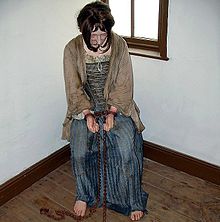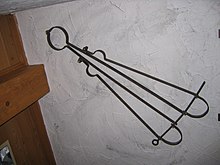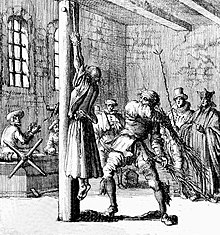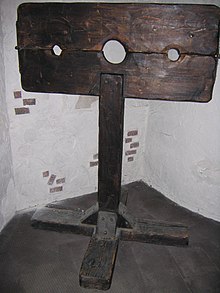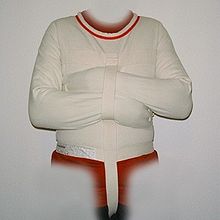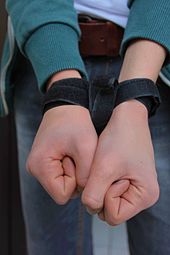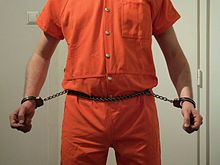Bondage (physical)
A restraint , sometimes also referred to as securing , describes any form of an externally induced restriction or abolition of the physical freedom of movement or freedom of movement of a person by rigidly enclosing and securing the limbs to one another or to immobile or heavy objects. The resulting restriction of freedom of movement is usually temporary, whereby the person concerned cannot free himself from his position. From a practical point of view, the primary points of impact are usually the wrists and ankles; in addition, securing is sometimes carried out by enclosing the abdominal region. In earlier times, the neck was also often used as an enclosure.
Characteristics
Traditional aids for enclosing the limbs have been metal handcuffs , ankle cuffs and chains in the epoch-dependent development stage, as well as ropes, ribbons, leather straps and belts from the Bronze Age to the present .
The decisive nature of the restraint is that the restrained person ideally does not have the opportunity to free himself from the restriction of physical freedom of movement imposed by the person being constrained and thus has to endure it. In the classic case (e.g. prisoners, kidnapping victims) this happens against the will and the interests of the handcuffed person, with the captivating person's own specific purpose. The handcuffed person is dependent on another person (e.g. prison officer, kidnapper, rescuer) loosening, changing or removing the handcuff. In any case, this is completely under external control for the duration of the bondage. In the meantime, outside people or institutions decide in their own full power according to their subjective interests whether and when the bondage is lifted or changed. The restraint thus has a comprehensive effect, since the restrained person usually effectively has no self-determination and decisions concerning them can be made comprehensively by strangers. The bondage thus creates a structure of steep hierarchy between powerlessness on the part of the tied person and outside control as well as access by people who have the possibility of direct influence on them.
hazards
In individual cases, restraints can lead to considerable physical pain, even injury or death, if they are maintained over a longer period of time and, above all, carried out without specialist knowledge or consideration for the person being tied up. Shackled people are to be supervised as a matter of principle, they must not be left alone for long periods of time. The reflex and movement functions of the bound extremities (hands / fingers, feet / toes) should be checked by a competent supervisor at regular intervals, especially in the case of long-term restraint and a high degree of movement restriction, in order to avoid disturbances of the blood circulation or damage to the nerve tracts as well as serious To prevent trauma to the affected areas of the skin on the handcuffed person. If the bondage is maintained over a longer period of time, superficial indentations usually appear on the enclosed skin areas, which tend to redden. Prolonged movement with unsuitable shackles can result in open wounds, particularly on the ankles, which must be treated medically to avoid infections. In the event of a reddish or bluish discoloration of the bound limbs or their swelling, loosen the ankle and wait for the condition to normalize; if necessary, the person needs medical care.
Shackling as a sovereign measure
Legal basis
A person can be shackled (also immobilized ) by private individuals or public officials . The aim is to avert danger , to enforce sentences or to prosecute . It represents a kind of immediate compulsion to enforce a measure . The reason for being tied is to protect oneself and others as well as to prevent escape . For reasons of self-protection, it is always advisable to shackle a person who is officially detained in case of doubt. In prison z. For example, in the United States, depending on the facility's classification, it is sometimes common practice to routinely handcuff prisoners as soon as they are moved outside of the cell. Here the purpose of the prison staff's own protection serves as a generalized authorization to shackle prisoners at any time. Handcuffs are always used here, which are placed behind the back in most cases and can optionally be combined with ankle cuffs and other securing devices such as a belly chain .
In Austria, Section 26 of the detention order regulates the circumstances under which a person who is in police custody may be handcuffed. Pursuant to Section 26 (2) of the detention order, it is permissible to handcuff an arrested person if, based on certain facts, there is a risk that the person concerned will 1.) endanger himself or others; 2.) damage other people's things not only of minor value; 3.) flee; 4.) try to thwart an official act in which he has to participate. According to Section 26 (3) of the arrest regulations, a risk of escape is to be assumed in particular if the detainee is suspected of having committed a crime or could use a situation that is favorable to escape in the event of execution or transfer and if there are no special reasons that make an attempt to escape unlikely. This means that people suspected of certain serious crimes (e.g. murder, robbery, rape, but also economic offenses such as serious fraud) can be routinely handcuffed. The use of other means of restraint than handcuffs (e.g. straitjackets) or additional means of restraint (e.g. ankle cuffs) is only permitted under Section 26 (4) of the detention order if the principle of proportionality is strictly observed and only if it can be assumed on the basis of certain facts that the prisoner would endanger his life or health, other people or property due to a mental illness or violence, and the use of handcuffs alone would not be sufficient for security purposes.
According to German and Austrian criminal procedure law , the accused should not be tied up at the main hearing . However, this can be broken in individual cases if a specific dangerous situation threatens to materialize for those involved.
Occasions
There are different reasons that lead to a bondage. Often times, not just a single reason is the cause of the bondage, but a combination of several reasons.
- Prevention of escape
- Prisoners are shackled to prevent them from escaping. For this purpose, the ability to move from the spot is either restricted (for example by putting on handcuffs and / or ankle cuffs ) or completely withdrawn (by restraints that make it impossible to walk independently (for example the hog tie , see below) ), or by shackling the prisoner to an object, for example by chaining them to a wall).
- Self protection
- People are shackled to prevent themselves from harming themselves (in case of mental confusion or acute suicidal risk), for example by being strapped to a bed or, in earlier times, by putting on a straitjacket . In the medical field this is called fixation , the use of the word bondage is frowned upon.
- External protection
The purpose of the bondage is to prevent the person being tied up from harming other people.
- Obtaining confessions, carrying out corporal punishment and executions
- People have been and are being handcuffed as part of the use of torture . Shackling is either a means to an end to prevent the shackled person from evading the use of torture, or it is a method of torture itself by means of very tight shackles. The latter was carried out in earlier times in Japan , for example . This category also includes the torture instrument stork , which squeezes the head (back), arms (middle) and ankles (front) together in such an uncomfortable way that it quickly causes severe cramps.
Furthermore, before corporal punishment , people were and are often handcuffed to make them largely incapable of movement, for example during flogging or the bastinado, which are still used by the judiciary in some countries today. Here, the restraint for the inability to move also serves to protect the person concerned, since involuntary movements during the execution of the corporal punishment due to the pain stimulus threatens the execution to otherwise become imprecise. Unintended areas of the body could be hit and unintentionally injured requiring treatment, which is prevented by the stringent restraint. When executing the death penalty , the convicts are usually handcuffed beforehand.
Games
At a certain stage of development, bondage is a popular game among children. In role-playing games such as cowboys and Indians or robbers and gendarmes , children tie each other up and learn (depending on their role as tied or tied) the associated feelings (exercise of power, powerlessness, humiliation).
In the tradition of some scout groups , one knows the pegging or pegs. The outstretched arms and legs of the “prisoner” are fastened with cords to four wooden pegs hammered into the ground, so that the prisoner can lie relatively comfortably, but hardly or not at all. From a pedagogical point of view, this tradition is controversial.
The art of escape
Deceitful spiritualists let themselves be tied up during necromancy held in the dark in order to apparently exclude manipulation of the phenomena caused. Nevertheless, they were able to bypass the shackles with ingenious tricks and give knock signals or simulate telekinetic effects. Towards the end of the 19th century, magicians developed the genre of escape art from this, in which the artist lets himself be tied up under test conditions, but overcomes them using techniques and tricks. The most versatile and well-known escape artist was the showman Harry Houdini .
Show of force
As a rule, putting on a shackle is perceived by the shackled person as an act of submission to the exercise of power by others, with the loss of any negotiating position. This is put against their will through the use of direct coercion and / or psychological pressure noticeably in the circumstance of total control and exercise of power by other people.
Insofar as the person to be tied up physically struggles to maintain their freedom of movement or locomotion, the physical breaking of the resistance offered and the overpowering of the person at the end of the tying means a de facto submission and a steep power gap is created. The shackles put on represent not only the result, but also a form of expression of the enforced power against the weak position and force the shackled person noticeably and visibly into the situation of lasting defenselessness and outside control. If the tied person tries to continue or again to struggle for their forfeited freedom, the initially palpable exercise of power in the form of the bondage continues effectively and sustainably, since these attempts regularly fail and the lost freedom of movement cannot be regained through one's own will. Rather, in these cases, the person (s) exercising the upper hand often extend the bondage to the point of practically complete inability to move the tied person, which further intensifies the effect of the demonstration of power.
If the person to be captivated behaves cooperatively, their toleration with usually opposing inner will represents the symbolic expression of being subject to and recognizing the existing power of the captivating person to abandon the limbs to be tied up, such as hands or feet, to the person (s) exercising power against their actual will and not to offer any external resistance. As far as no attempts at physical resistance are made in many cases, the actual submission of the person in the weak position continues in these cases in the form of bondage. The tied person is fully aware of the insurmountability of the shackles in this case and is constantly reminded of their inferiority and powerlessness through the constant feeling of the shackles and the unnatural restriction of movement. The fear of further adverse consequences, which the handcuffed person cannot avert himself, is thereby constantly maintained. So she continues to offer no resistance and behaves cooperatively. Here, too, the bondage serves as an expression of actually existing power vis-à-vis the person who actually submits.
On the part of the captivating person, the process is perceived in the opposite direction, here putting the shackles on a person who is overwhelmed in physical action or who surrenders and complies with the feeling of real exercise of power and superiority and triggers a psychological reward mechanism. These real impressions also continue when dealing with people who are already tied up; here, too, there is a clear feeling of superiority and power already in the knowledge that theoretically unhindered actions can be carried out on the tied person against their will or even suffering, in extreme cases such as Being able to inflict hostage-taking or even killing.
Effects
Forced wearing of shackles is felt by most people in regular social situations as humiliation as well as degrading and dishonorable. In this context, the shackles put on against the will of the person in question represent a symbol of the broken will of the shackled person that can be felt immediately and is visible to outsiders, both when putting them on and when wearing them. The partial or complete deprivation of freedom of movement with the associated powerlessness and the feeling of being defenseless at the mercy of and subordinate to the actions of strangers is usually associated with severe psychological stress and high suffering. This is all the more the case since in individual cases actions or toleration imposed by strangers in practically all cases are drastically contrary to the interests of the bound person. Thus, the constantly present fears already lead to high levels of suffering without the need for concrete repressive actions. Sometimes people are tied up in order to intimidate them, discourage them and break their will and so z. B. extorting confessions, extracting information or making the overwhelmed person docile. The bondage creates an almost overwhelming power imbalance for the tied person, since their well-being is objectively extensively dependent on the interests and will of other people. You yourself have no freedom of choice in personal or intimate matters and no delimited and protected privacy.
The ubiquitous knowledge of the shackled person that strangers in their situation have the practically unlimited power to inflict sensitive suffering on them, without them being able to even begin to prevent it, very often has a lasting impact on self-confidence and self-image of those affected. Many recover from this only gradually, even after the condition has ended, and often their self-confidence is permanently damaged. In the case of prisoners who do not have the opportunity to compensate for the experiences, as they keep recurring, at this point, after some time, they get used to the situation and even accept the unchangeable situation. Something similar is reported from longstanding kidnapping victims.
Most shackled people find it particularly humiliating to be presented in shackles in public. In earlier times, this was exploited in the application of honor penalties, for example by standing chained in the pillory . While prisoners who are tied up in Germany are hidden from the public as far as possible, it is the practice of the law enforcement authorities in the USA that suspects are chained through the public on a so-called perp walk and handcuffed behind their backs in the courtroom after they have been convicted become. In some states of the USA, prisoners are forced to do community service, during which they have to wear shackles and can also be seen by the general public (so-called chaingangs ). The person who is tied up and therefore visibly relieved of the possibility of self-determined decisions for outsiders suffers in many cases a lasting loss of social prestige and self-image, which often remain permanently damaged.
Another lasting form of humiliation is the shackling of partially or fully exposed persons who are prevented by their shackles from covering their nakedness. This is practiced in a moderate way in the United States of America, where the suspects who are admitted are often first of all confiscated and then have to endure the already humiliating admission procedure barefoot, while most of the time they are additionally handcuffed. Here, the prisoners have no way of covering their bare feet, but rather often have to present them, e.g. B. when setting up on lines or markings. The additional intimidating effect of being forced to be barefoot and the associated unaccustomed vulnerability and degradation towards the shod officials and civilian employees can effectively deter many prisoners from offering serious resistance or from behaving in a hostile manner towards the officials. In some American prisons, it is customary in this context, during potential confrontation, to have the prisoners remove their footwear before handcuffing them. First of all, it primarily serves the security of the officers, since involuntary kicks with bare feet also cause less serious injuries than those carried out under the protection of shoes. However, the prisoners are further intimidated and humiliated beyond the shackles and thus prevented from violent acts.
Preventing activities from being carried out
People are handcuffed to prevent them from performing any activity. For example, a criminal ties up his victim to prevent them from calling the police. Often the victims are also gagged . As shown above, people who are to be punished in the context of corporal punishment were and are mostly handcuffed largely immobile for the procedure in order to prevent them from evading an orderly execution.
execution
Ropes
This is probably the oldest form of bondage. Either hands and / or feet are tied together with ropes or the person is tied to an object (for example to a tree, a chair or a bed). If the hands are handcuffed in front of the body, the probability that the handcuffed person can free himself is high, if the hands are tied behind the back or to an object, it can be achieved that self-liberation is impossible. When the legs are tied, either the ankles are tied together or the legs are partially or completely wrapped with rope. Hostages are usually also gagged.
The most famous way of tying up with ropes is probably the tying of prisoners to the torture stake , as was practiced by the Indians and is often played out by children.
Another form of shackling with ropes - but also with other shackles such as B. handcuffs and ankle cuffs, especially in prison - is the so-called hogtie , in German usage sometimes referred to as immobilization: The tied person lies on his stomach, wrists and ankles are tightly tied together (the hands behind the body) with Using another rope or chain, the handcuffs and ankle cuffs are connected behind your back so that the knees are angled orthogonally to a sharp point and the feet point upwards. This bondage has a far-reaching effect, the tied person is practically immobile and can neither move nor afford any form of resistance or resistance. In American prisons, this type of restraint is sometimes euphemistically referred to as Shakira , as the physical movements of the prisoners bound in this way are essentially limited to hip movements and are thus reminiscent of the popular singer. In some cases, this bondage is maintained without interruption for periods of up to 48 hours.
Ropes were last officially used in Germany during the Nazi regime, especially in camps, but are no longer used by the police , the judiciary or in the medical field today . If the ropes were pulled too tight or the bound person was hung up by the shackles, as was often done in Nazi camps, the result could be considerable pain or even permanent injuries due to blood supply constriction or nerve damage.
node
The bondage knot , in which the hands or feet are put into two tightening loops, is particularly suitable .
Handcuffs and shackles, chains

Shackling only with chains , which are wrapped around the extremities of the person to be shackled like a rope and secured with a lock, is usually not found in the sovereign area, as the danger situation is similar to that of shackling with ropes, see section "Ropes". Normally, lockable metal cuffs are placed around the wrists and / or ankles of the person to be handcuffed, sometimes around the waist. Handcuffs are usually connected to one another by at least one chain link, footcuffs mostly by a multi-link chain, so that the freedom of movement is more or less restricted depending on the length of the chain. When shackling with chains, it is also spoken of "putting a person in chains" or "putting them in irons".
Both the bells and the chains were very thick and heavy in earlier times. Today much lighter clamps and chains are used. For the locking mechanisms of the cuffs, see handcuffs and footcuffs . For handcuffs and shackles, special requirements apply to the locking means used in the sovereign area.
The most common form of shackling with chains is handcuffs , with which the hands of the person to be shackled are chained together either in front of or behind the body. When tied up in front of the body, the tied person still has a great deal of freedom of movement, so that they can kick around with the tied hands and still pose a significant risk potential for other people, such as police officers or law enforcement officers but also bystanders. When tied behind the body, this dangerous situation is avoided, as the arms are brought outside of their natural range of motion. However, it can be uncomfortable or painful for the handcuffed person to sit (for example when being transported in a car) or to rest in this way. Being handcuffed, especially behind the back, considerably reduces the possibility of escape, as the arms are usually also moved when running (especially when running) in order to better maintain balance. Handcuffing is very common in the arrest of people by the police and in securing prisoners by the judiciary.
If the freedom of movement is to be restricted further, ankle cuffs are usually also put on. The chain between the ankle cuffs is usually many times longer than with the handcuffs, so that it is still possible to walk with a limited step length at a comparatively normal speed, provided the step change is increased accordingly. Due to the shortened stride length, however, only a comparatively low speed can be achieved by running movements, so that a fleeing person can usually be easily caught up and taken back into custody. Ankle cuffs are sometimes used in Germany to transport prisoners.
Until the early 20th century, iron balls connected with a chain and an ankle cuff were used to restrict the freedom of movement of prisoners. The handcuffed person was able to move largely unhindered as far as the chain reached. In order to move further, she had to pick up the iron ball from the ground and carry it, which, because of its weight, also made it slow and difficult to move.
In addition to putting on handcuffs and shackles, the restraint can be tightened with chains. In the USA it is customary to tie up prisoners with so-called combinations . These consist of a pair of handcuffs and ankle cuffs, which are connected to one another by an additional vertical chain; the chains thus form an H lying on its side. The hands are usually tied in front of the person to be tied up, less often behind the body, whereby the additional vertical chain prevents the hands from being raised further than the hips while standing. While sitting, the hands can be brought up to the face when tied up in front of the body, which is partially prevented by placing an additional chain ( belly chain ) or a leather belt around the hips, to which the handcuffs are fixed.
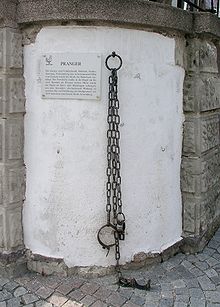
Before the introduction of modern prisons with adequate security, it was common to put prisoners in chains while they were in custody, usually their hands and / or feet were chained to a ring anchored in the wall or the floor, which was supposed to prevent them from escaping. In the past, neck irons were also used, which were placed around the neck of the person to be cuffed and locked. The chain on it was either connected to the other chains or to the wall. Neck irons were also used to shackle convicts in pillory .
Placing prisoners in lockable shackles is a relatively humane form of shackling compared to other methods of shackling (ropes, wooden blocks), because normally a certain freedom of movement remains with a high level of securing effect. Inappropriately tightly closed handcuffs or ankle cuffs can cause considerable pain and lead to injuries if worn for long periods. The heavy old bells of earlier times also chafed the skin. Even correctly applied modern-type bells can in individual cases represent torture or inhuman treatment. The ECtHR decided that it is not permissible to handcuff and shackle prisoners outside of the cell as long as there is no specific reason to do so. In the United States, the widespread practice of indiscriminate juvenile shackling has recently sparked discussion. It is criticized that the person concerned often perceives unreasonable shackling as degrading and humiliating, hampers participation in court proceedings and thwarted the idea of rehabilitation in juvenile criminal law. An initiative by defense lawyers has led to more and more states banning indiscriminate shackling and shackling to be permitted only if the person concerned poses a specific risk.
Wooden blocks
In the Middle Ages to the early modern period, wooden blocks were also used for tying up. For this purpose, two wooden blocks were placed on top of each other and fitted with a hinge on one side and a locking mechanism on the other. The wooden blocks were each given semicircular recesses, which were exactly on top of each other when closed. This created holes that enclosed the wrists, ankles or neck of the handcuffed person and that were so small that hands, feet or head could not be pulled through. Instead of connecting the wooden blocks with a hinge and lock, some of them were also screwed together. The tying with wooden blocks was essentially done in three different ways:
- Sitting on the floor : The method was mainly used to tie up prisoners in dungeons, and more rarely to use pillory punishment . The wooden blocks received either two holes for the feet or four holes for the hands and feet. The upper block was folded up or removed to put on the shackles. The person to be tied up had to sit down on the floor and place their ankles in the semicircular recesses provided for this purpose, as well as their wrists in the version with four holes. The upper block was then placed on top of the lower block and connected to it. In the version with two holes, the hands either remained free or were also tied, for example with U-shaped iron clamps that were mounted on the upper block, with a third wooden block that was additionally placed on the other two blocks or with chains. In the version with four holes, the ankles were locked in the two outer holes and the wrists in the two inner holes. This resulted in a very uncomfortable sitting position: the upper body had to be bent far forward, the legs were spread. The lower block was partially firmly connected to the ground.
- The yoke resembled the stick. It was used to tie the hands and has three holes: a larger one in the middle for the neck and two more on the outside for the wrists. In Germany in the Middle Ages, a different version was used, the so-called neck violin . The principle corresponds to that of the yoke, but wooden boards were used instead of blocks. The holes for the wrists were not to the left and right of the hole for the neck, but both on the same side, the hands were tied one behind the other in front of the neck, not next to it. The hinge was behind the neck, the lock in front of the hands. The neck violin was mainly used for light punishments , women and girls in particular were locked in and led through the city.
- A common form of pillory was a yoke that was firmly mounted on a wooden pole. The pillory encircled the condemned person's neck and wrists; she had to stand in a stooped position.
Shackling with wooden blocks offered itself in the Middle Ages, as this form of shackles was much easier to make than chains and iron bells. However, it is one of the most painful and cruel restraint methods, as the bound person is practically completely deprived of freedom of movement. A prisoner who is locked in a block of wood by his hands and feet is unable to ingest food on his own, much less to get rid of his excrement. The physical pain for those bound in this way must have been immense.
Straps and straps
Straps and belts are primarily used to strap people to objects. The most common use case is the strapping of confused patients to the bed, who otherwise could harm themselves or others. In this context, one speaks of a fixation. In the past, the person to be tied up was buckled up with leather belts, today belts made of textiles are used for this, as they are more hygienic (washable) and less martial. The easiest form of fixation is the waist belt . It is about 20 to 30 cm wide and is placed around the waist above the hips. The waist belt is connected to the bed beforehand so that the tied person can no longer leave it. Arms and legs can still be moved, however, and it is also possible to lie on your side.
If this type of fixation is not sufficient, additional restraints can be put on: Straps are also placed around the wrists and thus the arms are buckled. In the past, the hands were tied at the head of the bed or next to the head, today next to the body at the height of the hips. To restrain the legs, straps are placed around the ankles and strapped to the bed. The legs can still be secured with additional straps that are strapped around the thighs. To prevent the handcuffed person from straightening their upper body, straps are put on, which run over the shoulders like the straps of dungarees, cross on the back and are attached to the front and back of the waist belt. Further straps are attached to these in the shoulder area, which are attached to the head of the bed. A patient tied up in this way is practically completely helpless.
The implementation of such restraint in hospitals and nursing homes requires official approval. The restraint of patients is used less and less, however, and has often been replaced by the administration of sedatives.
The fixation with straps is the most humane form of restraint, since the straps are soft in contrast to iron clamps or wooden blocks and therefore there is no immediate risk of injury. Nevertheless, it is a more or less drastic restriction of physical freedom of movement, which can be uncomfortable and painful in the long run.
Sometimes strapping people to the bed is also used temporarily in prisons when prisoners get out of control. Another form of restraint with straps and belts is buckling up on specially designed chairs. A particularly drastic example of this is the electric chair , but people have also been and are strapped to chairs for immobilization, punishment, interrogation and the use of torture . In the German penal system, however, bondage in this form is not practiced.
In earlier times, prisoners were strapped to special beating blocks or benches with the help of leather straps and belts to carry out a whipping with a stick or bastinade . The upper body lay flat on the device on the shelf, hands and feet as well as often the upper body of the chastised person were strapped tightly to the device so that they were prevented from moving freely. The hands could also be tied behind the back during the bastinado. Because of the restraint, the person had no way of avoiding the blows, mostly on the buttocks or the soles of the feet, and had to hold out in the posture that was forced in this way for the duration of the procedure.
Straitjacket
Another form of medical restraint is the straitjacket . The arms of the person to be cuffed are put into the sleeves of the straitjacket, which have no opening at the end. The straitjacket is closed on the back by fastening numerous straps, the straitjacket is very close to the upper body. The arms are crossed in front of the upper body, at the end of the sleeves there are straps that are led to the back and fastened there. Another strap, the crotch band, is firmly attached to the back of the straitjacket, it is pulled through between the legs and strapped at the front so that the tied person cannot pull the straitjacket over their head. The straitjacket does not affect the freedom of movement of the legs, they either remain untied or have a separate ankle.
Straitjackets were previously used in psychiatry , but - at least in Germany - they are no longer used.
The restraint with the straitjacket looks relatively comfortable at first glance compared to other restraints. However, in order to prevent the handcuffed person from freeing himself / herself, the straitjacket, which is made of thick linen, must be very tight. This is achieved by pulling the straps very tight on the back, which can impair breathing. The arms are also close to the body, which is painful in the long run. Furthermore, the straitjacket is very warm, the tied person begins to sweat profusely in the long run. This is made even more pronounced if a diaper is worn in addition to the straitjacket , which is the norm in the medical field. Fixation by buckling up on the bed is much more humane than being tied with a straitjacket.
Plastic shackles
Plastic shackles, e.g. B. in the form of thicker cable ties , are sometimes used by the police to shackle the arrested, especially during demonstrations , where mass arrests are sometimes carried out. When opening the restraint, the disposable cable tie must be cut. Various manufacturers offer special versions for police purposes that are designed to prevent damage with the rounded edges of the tape. Reusable versions that can be opened with a standard handcuff key and double loops for the two wrists are also produced.
Other materials
Outside of sovereign use by the police, penal system or certified security companies, a wide variety of often very imaginative methods of restraint are used, above all with mutual consent in the area of interest of so-called BDSM , but also in the area of illegal crimes that are associated with deprivation of liberty of the victims , e.g. B. by hostage takers. Used on the above-mentioned traditional shackles addition, this objects are often everyday objects such as towels , scarves, nylons , tape , plush handcuffs , plastic film (cling film), cable, wire or Velcro . Depending on the material used, the risk of injury is significantly increased compared to the restraint instruments used by the government and developed according to safety aspects and should only be used with appropriate expertise and in any case with an emergency safety device (e.g. side cutters, scissors). Even with the handcuffs that are often used in the BDSM area (e.g. the plush handcuffs mentioned), inexpensive metal shackles should be avoided and professional shackles from well-known manufacturers should be used instead, as the inexpensive versions are mostly made of thin sheet metal and therefore have sharp edges have, use unsafe mechanisms that can bend and cannot be opened with sufficient security in an emergency and, moreover, cannot be adequately secured against unintentional further closing in almost all cases.
Shackles, Smith & Wesson production
Shackles made by Smith & Wesson :
- M-1 universal handcuffs with chain connection or hinge joint (M-1H): Handcuffs with a total of 31 locking positions, whereby the narrowest position is 25% smaller and the widest position 25% larger than standard handcuffs. This should also be used to tie up people with particularly strong or narrow wrists.
- M-100 standard handcuffs with chain connection: handcuffs with 23 locking positions, circumference of at least 150 mm to a maximum of 210 mm, connected by two chain links;
- M-110 oversized handcuffs or particularly restrictive ankle cuffs : In this model, two ankle cuffs of the M-1900 model are connected with only two chain links. There are 22 locking positions, a circumference of at least 195 mm to a maximum of 270 mm;
- M-300 standard handcuffs with hinge joint: handcuffs with 23 locking positions, circumference of at least 150 mm to a maximum of 210 mm, connected by a hinge joint;
- M-1800 belly chain with handcuffs attached to the side;
- M-1840 belly chain with steel loop (martin link) for threading handcuffs;
- M-1850 transport restraint , consisting of a pair of M-1 handcuffs and a pair of M-1900 ankle cuffs , connected by an 80 cm long chain;
- M-1900 ankle cuffs : ankle cuffs with 22 locking positions, circumference of at least 195 mm to a maximum of 270 mm, connected by a 40 cm long chain. The shape of the ankle cuffs is oval so that the cuffs adapt better to the anatomy of the ankle and thus exert less pressure on the Achilles heel.
Bondage in BDSM
In various sexual practices such as bondage , restraint is also used to increase sexual pleasure, to fix the partner or to enjoy the aesthetics associated with it . In addition to conventional restraint instruments, specially developed devices such as B. monogloves or cuffs equipped with D-rings for the hand and ankles are used. However, the starting position of the parties involved, acting amicably and within the framework of previously made agreements, is not directly comparable with the actual bondage, since the tied person has the option of ending the scenario and being freed from the bondage, as well as often bondage be used without any practical effect (e.g. so-called body bondage, armor).
swell
- ↑ RIS - Detention Order Section 26 - Consolidated Federal Law. In: www.ris.bka.gv.at. Retrieved December 2, 2016 .
- ^ RIS - Code of Criminal Procedure 1975 § 239 - Consolidated Federal Law. In: www.ris.bka.gv.at. Retrieved November 18, 2016 .
- ↑ Definition of the piling of VCP Fichtelgebirge ( memento of February 24, 2007 in the Internet Archive )
- ↑ Critique of Scouting Traditions in Facts (Switzerland) ( Memento from September 30, 2007 in the Internet Archive ) (PDF; 485 kB)
- ↑ a b : Crossing the Barbed Wire [1] . March 23, 2013
- ↑ HUDOC - European Court of Human Rights. In: hudoc.echr.coe.int. Retrieved November 14, 2016 .
- ↑ AMERICAN BAR ASSOCIATION, CRIMINAL JUSTICE SECTION: REPORT TO THE HOUSE OF DELEGATES, RESOLUTION. Retrieved November 14, 2016 .
- ↑ Campaign Against Indiscriminate Juvenile Shackling | NJDC . In: NJDC . ( njdc.info [accessed November 14, 2016]).
- ↑ South Prison, Saltmarket 1909: [2] . March 24, 2013
- ↑ Enris: Enris - Smith & Wesson 2 - handcuffs. Retrieved May 29, 2017 .
- ↑ Enris: Enris - Smith & Wesson 2 - handcuffs. Retrieved May 29, 2017 .
- ↑ Guenter K .: leg irons from the rest of the world. Retrieved May 29, 2017 .
